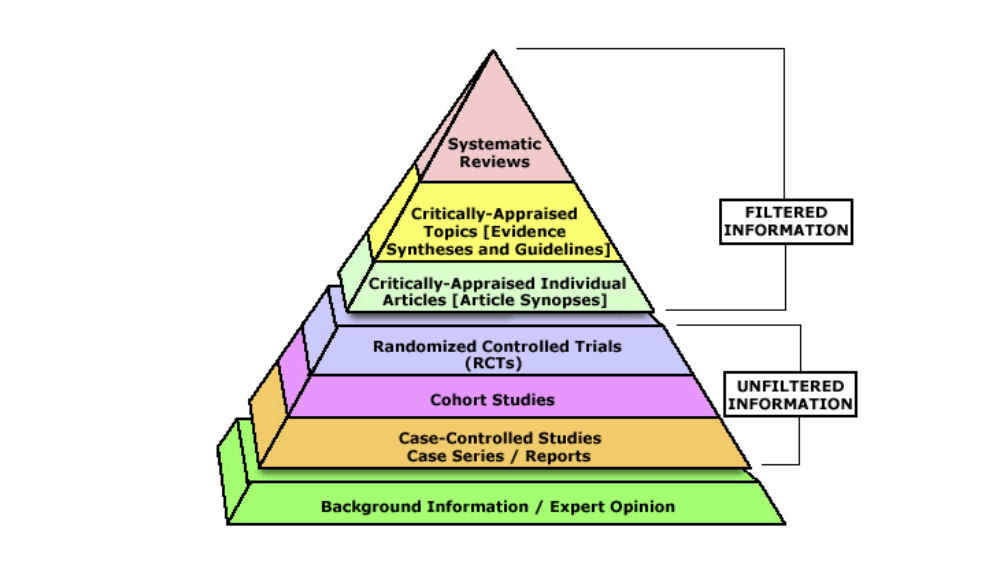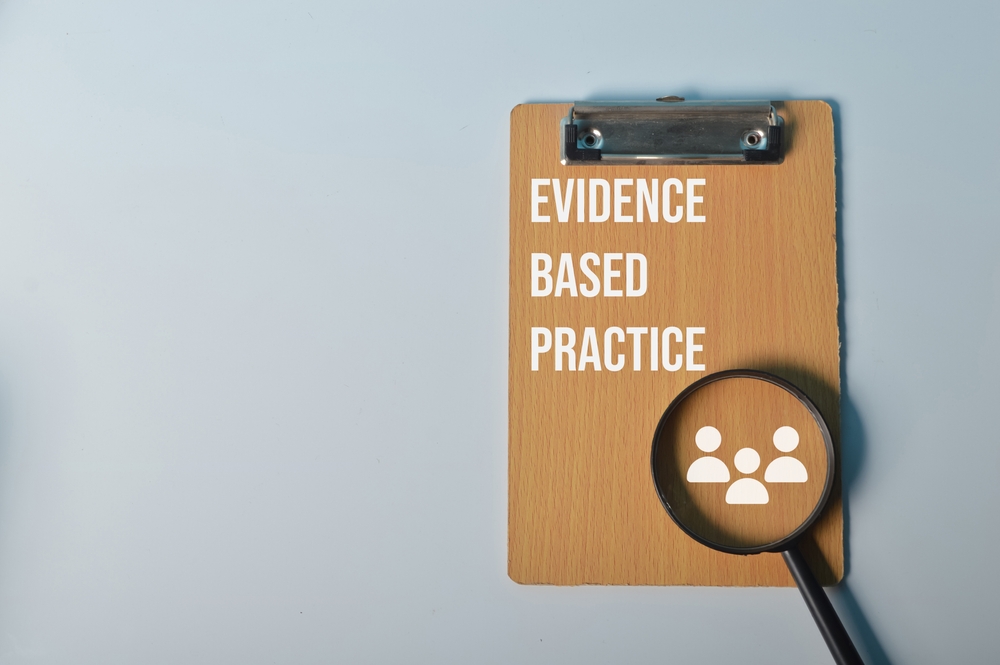The Evidence-Based Medicine Pyramid!
Posted on 29th April 2014 by Danny Minkow

You have seen the Pyramids of Egypt, you’ve heard of Maslow’s Pyramid of Needs and you’ve gotten more than your fill of the Food Pyramid.
Now, behold! The wonders of the Evidence-Based Medicine Pyramid!
What is the Evidence-Based Medicine Pyramid and why is it important?
The Evidence-Based Medicine Pyramid is simply a diagram that was created to help us understand how to weigh different levels of evidence in order to make health-related decisions. It helps us put the results of each study design into perspective, based on the relative strengths and weaknesses of each design.
Allow me to be your guide as we tour the Evidence-Based Pyramid.
As we approach, we can see the Evidence-Based Pyramid is divided into levels. Each ascending level represents a different type of study design and corresponds to increasing rigor, quality, and reliability of the evidence. In other words, as we ascend through these different study designs, we become more confident that their results are accurate, have less chance of statistical error, and minimize bias from confounding variables that could have influenced the results.
Information and expert opinion
The first level of the Evidence-Based Pyramid is the foundation. This background information is important and helpful. However, when viewed on its own, this type of evidence can be heavily influenced by beliefs, opinions, or even politics. This level might also include anecdotal evidence.
Case control studies or case series reports
This level represents the first stage of testing an observation. Case Series reports usually include only a few participants who are given a similar intervention and follow-up. Case Control Studies are similar to case series, except it looks retrospectively at individuals and compares with a similar group who did not have the intervention. These studies are conducted in the early stages of research to help identify variables that might predict a condition. One of the weaknesses in these designs is that there are small numbers of participants and they are frequently not randomized or controlled for confounding variables.
Cohort studies
Also called longitudinal or epidemiological studies, Cohort studies follow a large group of people over an extended period of time to see how their exposures affect their outcomes. This type of study is normally used to look at the effect of suspected risk factors that cannot be controlled experimentally – for example, the effect of smoking on lung cancer. These studies are frequently used to determine long term effects of a lifestyle, diet, or other interventions. Cohort studies may include a second group that did not engage in the same intervention as a control comparison. Although these studies are a step up in reliability and generalizability, they can be difficult to blind, can’t be controlled for outside variables, and are usually not randomized.
The Randomized Control Trial (RCT)
Now we have reached a major point in the Pyramid – the Randomized Control Trial, the true experimental design. In this study design, individuals are assigned by special randomization techniques into two or more groups, where one group receives the intervention under investigation and the other(s) receives no treatment, a placebo, or a standard intervention.
A large Double Blinded Randomized Control Trial is the most reliable “test” or study design and provides the strongest support of a cause and effect relationship. However, these studies are expensive and can be ethically problematic.
Critically appraised topics
Critically appraised topics are not actually a study design. They are short summaries of the best available evidence. Basically, these are an abbreviated systematic review created to answer a specific question.
The systematic reviews
Now we have finally arrived at the pinnacle of the Evidence-Based Medicine Pyramid.
From this dizzying height, we take in a panoramic view of all of the evidence about an intervention. Systematic reviews take a bird’s eye view by comparing the results of studies side by side, typically on a forest plot. Systematic reviews are considered the strongest and highest quality of evidence.
We could also include meta-analysis here as well. This is where multiple studies are reviewed and a statistical summary is made that represents the effect of the intervention across multiple studies.
Cochrane takes systematic reviews to the next level. They are the experts of the systematic review and have an added a level of rigor as an independent voice, as well as developing special techniques to identify bias in studies.
Well, I hope you have enjoyed this tour of the Evidence-Based Pyramid. So next time you hear about a “study” in the media or anywhere else be sure to find out what kind of study design was and where it falls on the Evidence-Based Medicine Pyramid.
Useful links:
The pyramid was produced by HLWIKI Canada. The original link is unfortunately no longer available, but the image is available
Glover, J. (n.d.). Yale University Library Subject Guides. Evidence-Based Clinical Practice Resources. Pyramid. Retrieved April 10, 2014.
Sedlacek, B. (n.d.). JML LibGuides. Evidence-Based Practice. Evidence Pyramid/Study Designs. Retrieved April 14, 2014.





No Comments on The Evidence-Based Medicine Pyramid!
Good overview
4th August 2023 at 12:20 pmhope your research goes well!!!!
15th January 2023 at 2:40 pmI am lookinf for the source of the pyramid, i.e., I want to cite it. Apparently, the HLWIKI does not exist anymore..
There are several variants on the internet (e.g., https://libguides.methodistcollege.edu/ebp/ebplevels, https://researchguides.library.tufts.edu/c.php?g=454103&p=3102416#s-lg-box-13868045). Some suggest that the pyramid is based on the Oxford Centre for Evidence-Based Medicine (CEBM) Levels of Evidence Table. But I cannot find a source that explicitely confirm so, or even shows how the pyramid was based on the table.
Any ideas who exactly made the pyramid, and based on what?
1st January 2023 at 6:50 pmHi Srinchtai. That is an interesting question and one that I don’t know the immediate answer to. As you have done, I have searched around for the original source now that the HLWIKI no longer exists and there are many sources using the pyramid. The Wikipedia page is interesting in mapping out the potential history: https://en.wikipedia.org/wiki/Hierarchy_of_evidence and one of our subsequent bloggers has written about the need to update the EBM period: https://s4be.cochrane.org/blog/2017/08/04/an-update-to-evidence-based-medicine-pyramid-why-and-how/. I will endeavour to search some more and ask the question of the S4BE community too.
6th January 2023 at 9:59 amHello to every body, it’s my first pay a visit of this website;
7th October 2018 at 1:11 pmthis web site contains remarkable and really good data in favoir
of readers.
Thank you — sure helps !
4th October 2018 at 4:01 pmMay I use your ‘evidence pyramid’ image for a class on information and research literacy for massage therapists?
15th April 2018 at 3:00 pmI like your posts and wanted to join
3rd January 2016 at 5:30 pmHi Halima, If you are a current student, you can register to join the community by selecting ‘register’ in the menu above.
4th January 2016 at 9:31 am